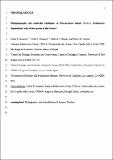Por favor, use este identificador para citar o enlazar a este item:
http://hdl.handle.net/10261/199410COMPARTIR / EXPORTAR:
 SHARE SHARE
 CORE
BASE CORE
BASE
|
|
| Visualizar otros formatos: MARC | Dublin Core | RDF | ORE | MODS | METS | DIDL | DATACITE | |

| Título: | Phylogeography and molecular phylogeny of Macaronesian island Tarphius (Coleoptera: Zopheridae): Why are there so few species in the Azores? |
Autor: | Amorim, Isabel R.; Emerson, Brent C. CSIC ORCID ; Borges, Paulo A.V.; Wayne, Robert K. | Palabras clave: | Azores diversity enigma Coleoptera Cryptic diversification COI COII Elongation factor 1α Island biogeography Island endemics Macaronesia speciation |
Fecha de publicación: | jul-2012 | Editor: | Blackwell Publishing | Citación: | Journal of Biogeography 39(09): 1583-1595 (2012) | Resumen: | Aim We used a phylogenetic framework to examine island colonization and predictions pertaining to differentiation within Macaronesian Tarphius (Insecta, Coleoptera, Zopheridae), and explain the paucity of endemics in the Azores compared with other Macaronesian archipelagos. Specifically, we test whether low diversity in the Azores could be due to recent colonization (phylogenetic lineage youth), cryptic speciation (distinct phylogenetic entities within species) or the young geological age of the archipelago. Location Macaronesian archipelagos (Azores, Madeira and the Canary Islands), northern Portugal and Morocco. Methods Phylogenetic analyses of mitochondrial and nuclear genes of Tarphius beetles of the Azores, other Macaronesian islands and neighbouring continental areas were used to investigate the origin of island biodiversity and to compare patterns of colonization and differentiation. A comparative nucleotide substitution rate test was used to select the appropriate substitution rate to infer clade divergence times. Results Madeiran and Canarian Tarphius species were found to be more closely related to each other, while Azorean taxa grouped separately. Azorean taxa showed concordance between species and phylogenetic clades, except for species that occur on multiple islands, which segregated by island of origin. Divergence time estimates revealed that Azorean Tarphius are an old group and that the most recent intra-island speciation event on Santa Maria, the oldest island, occurred between 3.7 and 6.1Ma. Main conclusions Our phylogenetic approach provides new evidence to understand the impoverishment of Azorean endemics: (1) Tarphius have had a long evolutionary history within the Azores, which does not support the hypothesis of fewer radiation events due to recent colonization; (2) the current taxonomy of Azorean Tarphius does not reflect common ancestry and cryptic speciation is responsible for the underestimation of endemics; (3) intra-island differentiation in the Azores was found only in the oldest island, supporting the idea that young geological age of the archipelago limits the number of endemics; and (4) the lack of evidence for recent intra-island diversification in Santa Maria could also explain the paucity of Azorean endemics. Phylogenetic reconstructions of other species-rich taxa that occur on multiple Macaronesian archipelagos will reveal whether our conclusions are taxon specific, or of a more general nature. | Versión del editor: | http://dx.doi.org/10.1111/j.1365-2699.2012.02721.x | URI: | http://hdl.handle.net/10261/199410 | DOI: | 10.1111/j.1365-2699.2012.02721.x | Identificadores: | doi: 10.1111/j.1365-2699.2012.02721.x issn: 0305-0270 e-issn: 1365-2699 |
| Aparece en las colecciones: | (IPNA) Artículos |
Ficheros en este ítem:
| Fichero | Descripción | Tamaño | Formato | |
|---|---|---|---|---|
| Phylogeography and molecular phylogeny_BEmerson12.pdf | 890,04 kB | Adobe PDF |  Visualizar/Abrir |
CORE Recommender
SCOPUSTM
Citations
25
checked on 18-abr-2024
WEB OF SCIENCETM
Citations
21
checked on 28-feb-2024
Page view(s)
191
checked on 19-abr-2024
Download(s)
264
checked on 19-abr-2024
Google ScholarTM
Check
Altmetric
Altmetric
Este item está licenciado bajo una Licencia Creative Commons

